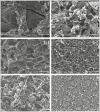Experimental Study of Surface Roughness of Dental Ceramics After Polishing with Three Types of Polishing Systems
- PMID: 36532324
- PMCID: PMC9753920
- DOI: 10.4103/jispcd.JISPCD_107_22
Experimental Study of Surface Roughness of Dental Ceramics After Polishing with Three Types of Polishing Systems
Abstract
Aims and objectives: This study evaluated the surface roughness of three dental ceramics after polishing with three types of extraoral ceramic polishing sets.
Materials and methods: One hundred and twenty specimens were fabricated from feldspathic porcelain, lithium disilicate, and zirconia ceramics. The specimens were randomly allocated into four subgroups (n = 10). Group one was glazed (control) and the other three groups were ground using fine diamond burs and then sequentially polished by two rubber wheels from three polishing sets: feldspathic porcelain, lithium disilicate, and zirconia sets. The surface roughness measurement was performed with a profilometer and the surfaces were analyzed using scanning electron microscopy. Elemental compositions of three polishing sets were examined using x-ray powder diffraction. The surface roughness values of three polishing systems were compared by one-way analysis of variance with Dunnett's T3 post hoc test. The significance level was set at p < 0.05.
Results: There was no significant difference in surface roughness when polishing ceramics with the lithium disilicate and zirconia polishing sets. In addition, those two sets provided lower roughness compared with the feldspathic porcelain polishing set and glazing. The main component of all polishing wheels was carbon, and only zirconia polishing wheel had more additional trace elements, which were titanium and silica.
Conclusion: Lithium disilicate and zirconia extraoral polishing sets achieved superior results compared to feldspathic polishing set and glazing.
Keywords: Dental ceramic; glazing; polishing; surface roughness.
Copyright: © 2022 Journal of International Society of Preventive and Community Dentistry.
Conflict of interest statement
The authors declare that there is no conflicts of interest.
Figures



Similar articles
-
Comparing the effect of two polishing systems on surface roughness of feldspathic, lithium disilicate, and translucent zirconia ceramics after orthodontic bracket debonding: An in vitro study.Int Orthod. 2024 Dec;22(4):100923. doi: 10.1016/j.ortho.2024.100923. Epub 2024 Sep 26. Int Orthod. 2024. PMID: 39332084
-
Effect of Two Polishing Systems on Surface Roughness, Topography, and Flexural Strength of a Monolithic Lithium Disilicate Ceramic.J Prosthodont. 2019 Jan;28(1):e172-e180. doi: 10.1111/jopr.12586. Epub 2017 Mar 8. J Prosthodont. 2019. PMID: 28273681
-
[Research on friction and wear behaviors of silicon-lithium spray coating on zirconia ceramics].Beijing Da Xue Xue Bao Yi Xue Ban. 2023 Feb 18;55(1):94-100. doi: 10.19723/j.issn.1671-167X.2023.01.014. Beijing Da Xue Xue Bao Yi Xue Ban. 2023. PMID: 36718695 Free PMC article. Chinese.
-
Natural teeth wear opposite to glazed and polished ceramic crowns: A systematic review.Dent Res J (Isfahan). 2022 Dec 14;19:108. eCollection 2022. Dent Res J (Isfahan). 2022. PMID: 36605138 Free PMC article. Review.
-
Polishing for glass ceramics: which protocol?J Prosthodont Res. 2014 Jul;58(3):160-70. doi: 10.1016/j.jpor.2014.02.001. Epub 2014 Mar 28. J Prosthodont Res. 2014. PMID: 24684959 Review.
Cited by
-
The Surface Roughness of Contemporary Indirect CAD/CAM Restorative Materials That Are Glazed and Chair-Side-Finished/Polished.Materials (Basel). 2024 Feb 21;17(5):997. doi: 10.3390/ma17050997. Materials (Basel). 2024. PMID: 38473470 Free PMC article.
-
Evaluation of Surface Roughness of Multilayered Monolithic Zirconia Following Chairside Adjustment with 3 Different Polishing Systems Sterilized for Multiple Cycles: An In Vitro Study.Med Sci Monit. 2025 Mar 8;31:e947231. doi: 10.12659/MSM.947231. Med Sci Monit. 2025. PMID: 40055890 Free PMC article.
-
Polishing systems for modern aesthetic dental materials: a narrative review.Br Dent J. 2024 Oct;237(8):607-613. doi: 10.1038/s41415-024-7963-x. Epub 2024 Oct 25. Br Dent J. 2024. PMID: 39455773 Free PMC article. Review.
References
-
- Fahmy NZ, El Guindy J, Zamzam M. Effect of artificial saliva storage on microhardness and fracture toughness of a hydrothermal glass-ceramic. J Prosthodont. 2009;18:324–31. - PubMed
-
- Kalia P, Nair KC, Jaiswal D, Tikmani C, Banerjee D, Bera R. A comparative study on the effect of polishing systems on the color and surface texture of different porcelain systems - feldspathic, pressable, and computer-aided design/computer-aided manufacturing. J Indian Prosthodont Soc. 2021;21:173–9. - PMC - PubMed
-
- Carrabba M, Vichi A, Vultaggio G, Pallari S, Paravina R, Ferrari M. Effect of finishing and polishing on the surface roughness and gloss of feldspathic ceramic for chairside CAD/CAM systems. Oper Dent. 2017;42:175–84. - PubMed
-
- Ismail NH, Awang RA, Kung HS. Surface roughness and colour stability of dental porcelain treated with different polishing methods. Int J Dent Oral Sci. 2020;7:766–9.
-
- Mohammadibassir M, Rezvani MB, Golzari H, Moravej Salehi E, Fahimi MA, Kharazi Fard MJ. Effect of two polishing systems on surface roughness, topography, and flexural strength of a monolithic lithium disilicate ceramic. J Prosthodont. 2019;28:e172–80. - PubMed
LinkOut - more resources
Full Text Sources

